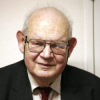Benoit Mandelbrot

Benoit Mandelbrot
Benoit B. Mandelbrot was a Polish-born, French and American mathematician with broad interests in the practical sciences, especially regarding what he labeled as "the art of roughness" of physical phenomena and "the uncontrolled element in life." He referred to himself as a "fractalist". He is recognized for his contribution to the field of fractal geometry, which included coining the word "fractal'", as well as developing a theory of "roughness and self-similarity" in nature...
NationalityFrench
ProfessionMathematician
Date of Birth20 November 1924
CountryFrance
Most were beginning to feel they had learned enough to last for the rest of their lives. They remained mathematicians, but largely went their own way.
Bottomless wonders spring from simple rules, which are repeated without end.
Why is geometry often described as 'cold' and 'dry?' One reason lies in its inability to describe the shape of a cloud, a mountain, a coastline, or a tree. Clouds are not spheres, mountains are not cones, coastlines are not circles, and bark is not smooth, nor does lightning travel in a straight line... Nature exhibits not simply a higher degree but an altogether different level of complexity.
Think not of what you see, but what it took to produce what you see.
One couldn't even measure roughness. So, by luck, and by reward for persistence, I did found the theory of roughness, which certainly I didn't expect and expecting to found one would have been pure madness.
The most important thing I have done is to combine something esoteric with a practical issue that affects many people.
A fractal is a way of seeing infinity.
Smooth shapes are very rare in the wild but extremely important in the ivory tower and the factory
Being a language, mathematics may be used not only to inform but also, among other things, to seduce.
Think of color, pitch, loudness, heaviness, and hotness. Each is the topic of a branch of physics
The most complex object in mathematics, the Mandelbrot Set ... is so complex as to be uncontrollable by mankind and describable as 'chaos'.
Everybody in mathematics had given up for 100 years or 200 years the idea that you could from pictures, from looking at pictures, find new ideas. That was the case long ago in the Middle Ages, in the Renaissance, in later periods, but then mathematicians had become very abstract.
Engineering is too important to wait for science.
An extraordinary amount of arrogance is present in any claim of having been the first in inventing something.